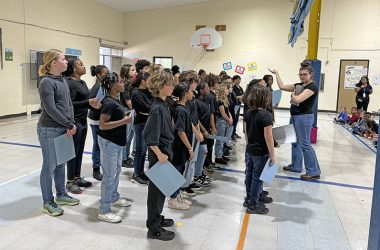Marc Fishman told his fifth grader that the Robot Club he enjoys after school may not be available to him next year.
“Just the look on his face when I told him that could go away, he was wide-eyed,” Fishman said. “Then he asked ‘Why? I don’t understand.’ And on top of that, there are (other proposed cuts) that he doesn’t understand, like class size.”
Kathy Leahy’s son plays the trumpet in band.
“I would not like that to go away,” she said of the proposed cut to music and art programs.
Cathy Wilson has a child in each school in the district.
“I am a mother of a child that has special needs. I am the mother of a child that is very active in choir and after school activities, so it was very alarming to see all of the cuts that could happen. It’s scary to hear that everything that they need could be taken away. All of the things that the district is made of could be disappearing.”
Aubree Sanders’ child is in kindergarten. She said the district’s memo to parents left her with questions, so she was at an information meeting Oct. 13 to learn more about the proposed $2 million in cuts.
The District 153 school board members approved the proposed cuts for next school year as recommenced by Superintendent Scott McAlister at the October board meeting.
If the Nov. 8 tax referendum fails, District 153 would experience:
- Eliminating all band, choir and music programs.
- Eliminating all after-school activities, including clubs and sports.
- Staff cuts in the administrative office.
- Staff cuts at each school building.
- Increasing class sizes due to eliminating one teaching position at each grade level kindergarten through fifth grade.
- Eliminating physical education positions and possibly moving away from daily PE classes.
- Eliminating one certified staff at each building.
- Eliminating teacher assistant positions.
- Eliminating one clerical position at each school.
McAlister said the list will get the district $2.3 million in cuts to cover the red ink in the budget, but it will be painful.
“The (deficit) number is so large that we have to look at everything,” he said. “Unfortunately, we’re in a position where if we don’t’ get the additional revenue to support these programs, difficult cuts will have to be made, and I think it would be difficult for the kids and the culture and identity that we’ve established for decades now.”
Members of the Citizens for Homewood Schools group have been out canvassing neighborhoods to share information on the referendum.
The tax rate was last increased 30 years ago. Why didn’t the district ask for an increase sooner?
“It wasn’t until last year that the state allowed for the kind of tax increase the school board is proposing,” said School Board President Shelly Marks.
The next best solution was to sell working cash bonds, so twice — in 2011 and 2016 — voters approved referendums allowing for temporary tax increases to cover those costs.
McAlister gave this analogy: Right now, the district is trying to fill a bathtub with a bucket of water. Each time a referendum passed, the district poured the money from the working cash bonds into the tub and it drained out a bit each year to cover costs.
“Now, we want to turn the faucet on to give us a continuous stream,” he said.
The increase is expected to help the district for at least the next 20 to 25 years.
The increase to the educational tax rate will jump the current rate of $4.40 per $100 assessed value of property to $5.60. The new rate would appear on the 2023 tax bills.
Marks said the cuts are sickening, especially because she knows each person that would be affected by a job elimination cares deeply for the students and the work they do.
“Every single position is one we need to contribute to student success academically, emotionally, socially. There isn’t one person working in this district that doesn’t contribute to student success, doesn’t create our vision of what Homewood schools should be,” she said.
Board members believe strong schools contribute to a strong high school and a strong community.
“We know how much this changes not just this district tremendously, but this community tremendously. It’s not just 153. We’ve got to make sure this happens for these kids,” said board member Jim Schmidt.


